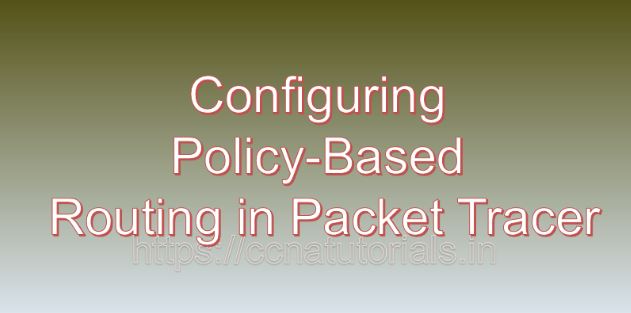Contents of this article
In this article, I describe the process of Configuring Policy-Based Routing in Packet Tracer. In the realm of networking, efficient routing of data packets is essential for ensuring optimal performance and resource utilization within a network infrastructure. While traditional routing protocols such as RIP, OSPF, and BGP handle routing decisions based on destination IP addresses, there are scenarios where more granular control over packet forwarding is necessary. This is where Policy-Based Routing (PBR) comes into play. PBR allows network administrators to implement routing policies based on specific criteria, such as source IP addresses, protocols, or packet attributes. In this comprehensive guide, we will delve into the concept of Policy-Based Routing, discuss its significance, and provide a detailed tutorial on configuring PBR using Cisco Packet Tracer, a versatile network simulation tool.
Understanding Policy-Based Routing (PBR)
Policy-Based Routing (PBR) is a routing technique that enables administrators to control the path of network traffic based on defined policies or conditions. Unlike traditional routing protocols, which make routing decisions solely based on destination IP addresses, PBR allows administrators to implement customized routing policies based on a variety of factors, including source IP addresses, packet attributes, protocol types, and more.
Significance of Policy-Based Routing
The implementation of Policy-Based Routing offers several significant benefits for network administrators:
- Granular Traffic Control: PBR allows administrators to define specific criteria for routing decisions, enabling them to direct traffic along predetermined paths based on factors such as source IP addresses, application types, or quality of service (QoS) requirements.
- Optimization of Network Resources: By directing traffic based on specific policies, PBR helps optimize network resources and bandwidth utilization. Administrators can prioritize critical applications or services, distribute traffic evenly across multiple links, and avoid network congestion in specific segments.
- Load Balancing and Redundancy: PBR facilitates load balancing and redundancy by enabling administrators to distribute traffic across multiple paths or links. In scenarios where multiple paths to a destination exist, PBR can intelligently distribute traffic based on predefined policies, ensuring efficient utilization of available resources.
- Security and Compliance: PBR can be used to enforce security policies and compliance requirements by directing traffic through designated security appliances or filtering devices. Administrators can implement access control policies, traffic filtering, or traffic redirection based on security criteria, enhancing network security posture.
Configuring Policy-Based Routing in Packet Tracer
Now, let’s explore the practical aspect of configuring Policy-Based Routing in Cisco Packet Tracer. For this demonstration, we will simulate a network topology consisting of routers, switches, and multiple hosts interconnected via Ethernet interfaces. The objective is to configure PBR on a router to direct traffic based on specific criteria.
Step 1: Create the Network Topology
Launch Cisco Packet Tracer and create a new network topology. Place two routers, a switch, and at least two host devices on the workspace. Connect the devices using appropriate cables, ensuring connectivity.
Step 2: Configure Router Interfaces
Access the CLI of the router where PBR will be configured and configure the interfaces connected to the switch and hosts. Assign IP addresses to the interfaces and enable them. For example:
Router(config)# interface GigabitEthernet0/0
Router(config-if)# ip address 192.168.1.1 255.255.255.0
Router(config-if)# no shutdown
Router(config-if)# exitRouter(config)# interface GigabitEthernet0/1
Router(config-if)# ip address 10.0.0.1 255.255.255.0
Router(config-if)# no shutdown
Router(config-if)# exitStep 3: Define Access Control Lists (ACLs)
Create access control lists (ACLs) to define the criteria for policy-based routing. ACLs can be based on source IP addresses, destination IP addresses, protocols, or any other relevant criteria. For example, to create an ACL to match traffic from a specific source IP address range:
Router(config)# access-list 100 permit ip 192.168.1.0 0.0.0.255 anyStep 4: Configure Policy-Based Routing
Configure the policy-based routing on the router to match the defined ACL and specify the next-hop router or outgoing interface for matching traffic. For example, to configure PBR to route traffic matching ACL 100 to a specific next-hop IP address:
Router(config)# route-map PBR_MAP permit 10
Router(config-route-map)# match ip address 100
Router(config-route-map)# set ip next-hop 10.0.0.2
Router(config-route-map)# exitRouter(config)# interface GigabitEthernet0/0
Router(config-if)# ip policy route-map PBR_MAP
Router(config-if)# exitStep 5: Verify Configuration
Finally, verify the configuration by examining the PBR configuration and the routing table:
Router# show route-map
Router# show ip routeThese commands display the configured route map for policy-based routing and the routing table, allowing you to verify the applied routing policies.
Conclusion for Configuring Policy-Based Routing in Packet Tracer
In conclusion, Policy-Based Routing (PBR) provides network administrators with a powerful tool for controlling the flow of traffic within a network infrastructure based on predefined policies or conditions. By configuring PBR, administrators can optimize network resources, enhance security, and ensure efficient traffic management in complex networking environments. Through the step-by-step tutorial provided in this guide, network professionals can leverage Cisco Packet Tracer to implement Policy-Based Routing, thereby gaining granular control over network traffic and optimizing the performance of their network infrastructures.
As organizations continue to grow and evolve, the adoption of Policy-Based Routing emerges as a fundamental strategy for addressing diverse networking challenges and achieving business objectives effectively. I hope you found this article helpful related to the process of Configuring Policy-Based Routing in Packet Tracer. You may drop a comment below or contact us for any query or suggestions related to the contents of this website.






